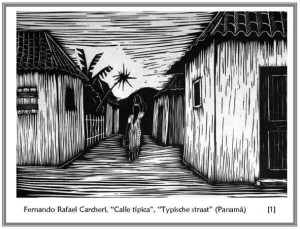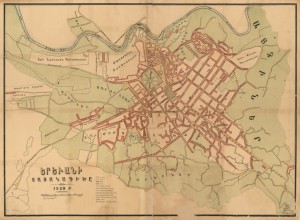Terug naar Macondo – Bij dit boek
 Terug naar Macondo begon met een lezing van de roman Honderd jaar eenzaamheid (1967) van de Colombiaanse schrijver Gabriel García Márquez. ’s Avonds, thuis op de bank. In die periode was ik al uitvoerig bezig met een sociaal-cultureel wetenschappelijk onderzoek naar de continuïteit van de inheemse cultuur van Latijns-Amerika. Ik had mij verdiept in de amerindiaanse scheppingsverhalen, zoals die van de Maya’s, de Azteken, de Inka’s, de Mapuche en diverse Amazonevolken. Ofschoon het lezen van García Márquez’ roman in feite niets met mijn academische onderzoekswerk van doen had, kreeg ik al spoedig last van een déjà vu. Ik had als het ware Honderd jaar eenzaamheid al gelezen in die scheppingverhalen maar wist tegelijkertijd dat García Márquez zich nooit een indio, indígena, inheemse of amerindiaan had genoemd. Integendeel, als er amerindio’s in zijn werk voorkomen dan voert hij ze op als behorend tot een andere wereld. Als hij naar eigen zeggen iets is, dan een caribeño, een inwoner van het Caraïbische Gebied van Colombia. Ik wist ook dat de inheemse geschiedenis van Colombia moeilijk op één lijn te plaatsen is met die van Mexico, Guatemala, Ecuador, Peru of Bolivia. Voor romans die de inheemse wereldvisie presenteren moest ik werken van de Peruaan José María Arguedas (1911-1969) of de Guatemalteek Miguel Ángel Asturias (1899-1974), winnaar van de Nobelprijs in 1967, uit de bibliotheek halen. Het was bekend dat Asturias zich diepgravend had ingeleefd in de Maya wereld en dat Arguedas romans en verhalen schreef die waren gebaseerd op zijn jeugd in een Quechua omgeving. Het kon niet zijn dat García Márquez tot hun wereld behoorde. Bovendien, Honderd jaar eenzaamheid was vooral een succes onder de mestiezen van Mexico, Colombia, Peru, Ecuador, Argentinië en nog enkele landen. En waarom zouden mestiezen zich identificeren met een amerindiaans scheppingsverhaal?
Terug naar Macondo begon met een lezing van de roman Honderd jaar eenzaamheid (1967) van de Colombiaanse schrijver Gabriel García Márquez. ’s Avonds, thuis op de bank. In die periode was ik al uitvoerig bezig met een sociaal-cultureel wetenschappelijk onderzoek naar de continuïteit van de inheemse cultuur van Latijns-Amerika. Ik had mij verdiept in de amerindiaanse scheppingsverhalen, zoals die van de Maya’s, de Azteken, de Inka’s, de Mapuche en diverse Amazonevolken. Ofschoon het lezen van García Márquez’ roman in feite niets met mijn academische onderzoekswerk van doen had, kreeg ik al spoedig last van een déjà vu. Ik had als het ware Honderd jaar eenzaamheid al gelezen in die scheppingverhalen maar wist tegelijkertijd dat García Márquez zich nooit een indio, indígena, inheemse of amerindiaan had genoemd. Integendeel, als er amerindio’s in zijn werk voorkomen dan voert hij ze op als behorend tot een andere wereld. Als hij naar eigen zeggen iets is, dan een caribeño, een inwoner van het Caraïbische Gebied van Colombia. Ik wist ook dat de inheemse geschiedenis van Colombia moeilijk op één lijn te plaatsen is met die van Mexico, Guatemala, Ecuador, Peru of Bolivia. Voor romans die de inheemse wereldvisie presenteren moest ik werken van de Peruaan José María Arguedas (1911-1969) of de Guatemalteek Miguel Ángel Asturias (1899-1974), winnaar van de Nobelprijs in 1967, uit de bibliotheek halen. Het was bekend dat Asturias zich diepgravend had ingeleefd in de Maya wereld en dat Arguedas romans en verhalen schreef die waren gebaseerd op zijn jeugd in een Quechua omgeving. Het kon niet zijn dat García Márquez tot hun wereld behoorde. Bovendien, Honderd jaar eenzaamheid was vooral een succes onder de mestiezen van Mexico, Colombia, Peru, Ecuador, Argentinië en nog enkele landen. En waarom zouden mestiezen zich identificeren met een amerindiaans scheppingsverhaal?
Volgens de Mexicaanse schrijver Carlos Fuentes moeten de Latijns-Amerikanen zich werkelijk in Honderd jaar eenzaamheid herkend hebben. Als ik de critici mag geloven, was de roman juist daarom in Latijns-Amerika een groter succes dan welke andere roman dan ook. Goed, maar wat herkennen ze dan? Of wie? Macondo, het dorp van de handeling? De geschiedenis van burgeroorlogen en militair geweld? De Buendía’s, het geslacht dat de roman beheerst? Zeker, waar wij bij ‘Bagdad’ denken aan 1001 Nacht en de mystiek van het Midden-Oosten – al hebben Sadam Hoessein en George Bush Sr én Jr dat beeld grotendeels verziekt – hangt Macondo gedrapeerd als het Latijns-Amerikaanse dorp tussen mythe en atlas. Macondo wordt serieus genomen tot in de collegebanken toe. Studenten zijn bijvoorbeeld herhaaldelijk verplicht Honderd jaar eenzaamheid te lezen. Over Macondo, een fictief dorp, de schepping van een schrijver. Toen de literatuurwetenschapper Gene Bell-Villada aan García Márquez vroeg wat hij hiervan vond, antwoordde de Colombiaan*:
Dat specifieke feit kende ik nog niet maar ik heb wel een aantal soortgelijke interessante ervaringen gehad. De Franse Econoom René Dumont publiceerde onlangs een lange academische studie over Latijns-Amerika. Midden in zijn bibliografie, tussen allerlei wetenschappelijke monografieën en statistische analyses stond Honderd jaar eenzaamheid! En op een keer kwam een socioloog uit Austin, Texas, naar mij toe omdat hij ontevreden was met zijn methodologie, vond die te droog, onvoldoende. Dus vroeg hij me wat mijn methode was. Ik heb hem geantwoord dat ik er geen heb. Ik lees een hoop, denk veel na, en herschrijf onafgebroken. Het is niet wetenschappelijk.[i]
Op intuïtie dus, op gevoel. Is dit ‘gevoel’ wat zijn lezers herkenden? Om de vraag naar de herkenning werkelijk te beantwoorden zouden we de miljoenen lezers een enquêteformulier moeten opsturen. Onbegonnen werk. Uiteraard ligt het antwoord ook in het boek zelf besloten maar een lezing van de roman blijft altijd mijn lezing. Een analyse, hoe gedegen ook, zou nimmer een ‘hard’ antwoord opleveren, in het beste geval hooguit een goed onderbouwde hypothese. Hoever kan ik gaan? Zal ik luisteren naar de raadgeving van een andere schrijver?
De Engelse auteur Salman Rushdie raadde het volgende aan: Go for broke. Always try and do too much. Dispense with safety nets. Take a deep breath before talking. Aim for the stars. Keep grinning. Be bloody-minded. Argue with the world.[ii] Read more
Kelsey Campbell-Dollaghan – How A Chinese Company 3D-Printed Ten Houses In A Single Day
gizmodo.com. April 2014. This month, architects in Amsterdam started work on the world’s first completely 3D-printed house. It’ll take three years and quite a bit of money to finish. Meanwhile, in Shanghai, a company claims to have printed ten houses with inexpensive industrial scraps in less than a day. What’s the difference?
It depends on your definition of 3D printing. Both projects are using massive 3D printers; in Shanghai, it’s 490 feet long, 33 feet wide, and 20 feet deep. Rather than expensive plastic, though, the Chinese company WinSun Decoration Design Engineering Co is printing with a concrete aggregate “made in part from recycled construction waste, industrial waste, and tailings,” according to the Architect’s Newspaper. Each of these homes costs less than $5,000.
Read more: http://gizmodo.com/how-a-chinese-company
Iraq – The Ministry Of Planning Reveal A 2.45 Million Iraqis Are Living In Slums
dinardaily.net. April 2014. The Ministry of Planning revealed that 2.45 million Iraqis are living in slums in the cities and parties across the country in the statistic reflects the extent of the housing crisis in Iraq.And spreading slums on the outskirts of cities due to increasing numbers of people and the displacement of villagers towards the cities in the past three decades as a result of the deterioration of the country’s economy.And Iraq fought several wars since the early eighties of the last century and the siege imposed on him for more than 10 years, which led to the destruction of various sectors and infrastructure.The agent said the Ministry of Planning Mahdi Keywords for site ‘Twilight News’ that the slums scattered across Iraq’s provinces inhabited by a gathering of 1552 2.00045 million thousand people by 346 000 family.He said the capital Baghdad, containing one-third of the random gatherings of Nineveh and Basra followed, while considered less Karbala and Najaf provinces in the number of slums.
http://www.dinardaily.net/ministry-of-planning
Craig White – Hot Docs 2014 Has Plenty For Urban And Architectural Enthusiasts
 urbantoronto.ca. April 12, 2014 .If you find yourself glued to UrbanToronto for stories about Toronto’s changing urban form, new buildings, and the urban experience, then you’re a pretty good candidate to fill seats at the Hot Docs international documentary film festival, set to hit Toronto over eleven days at the end of this month and the beginning of May.
urbantoronto.ca. April 12, 2014 .If you find yourself glued to UrbanToronto for stories about Toronto’s changing urban form, new buildings, and the urban experience, then you’re a pretty good candidate to fill seats at the Hot Docs international documentary film festival, set to hit Toronto over eleven days at the end of this month and the beginning of May.
The festival includes 197 selections this year from 43 countries covering a huge range of topics—essentially the best documentary films from across the globe made in the last year—along with some returning classics. There are particular spotlights on Danish-made docs this year, and Canadian ones of course, along with retrospectives of work by directors John Zaritsky and Adam Curtis. The documentaries inform, amuse, shock, and invariably take you to places you have never been, and some you have never even heard of before.
Read more: http://urbantoronto.ca/hot-docs-2014
Sina Zekavat – Becoming A Post-Soviet City: Social Housing And Urban Planning In Yerevan

Map 1: First official map of Yerevan published in 1920 prior to the implementation of Tamanian’s radial plan.
ajammc.com. April 2014. It is impossible to walk around Yerevan today and not notice the melancholic presence of one building typology across this rapidly changing urban landscape: The Soviet social housing block. Far from being a clean break from the past, the Soviet housing legacy remains highly present and influential in the daily experience of Yerevan. These grey and often crumbling buildings constitute the largest share of housing in Armenia. Unlike some countries with longer capitalist heritages where social housing has become marginalized as a place for the poor, in Yerevan and in many other post-socialist Eurasian cities like Baku, Tbilisi and Tashkent, these housing blocks still provide the most common and accessible living conditions for average citizens.
Through careful observation of Yerevan’s Soviet housing legacy as well as Yerevan’s current transformations this article aims to explore the slow decay of socialism as a complex and multilayered process that symbolizes not simply the death of a particular utopia or ideology but also the emergence of new, and often conflicting, notions of belonging and nationhood.
Yerevan is the capital and the largest city of Armenia. With a population of 1.117 million, it contains approximately 34% of the total population and 54% of the urban population of Armenia. The city’s origin dates back to the 8th century BC when settlements started to grow along the banks of Hrazdan River at the northeast of the Ararat plain.
Read more: http://ajammc.com/yerevan-becoming-a-post-soviet-city/
Lauren Royston & Michael Clark – Urbanisation: Low-Cost Housing Not Low-Cost Enough
Mail & Guardian, April 11, 2014. Urbanisation is inevitable, whether or not election manifestos or government policy documents acknowledge it as such. Approximately 60% of the South African population currently lives in urban areas. This figure will increase as a result of natural population growth and the further migration of people to cities in search of economic opportunities.
In many African countries, including South Africa, the standard government response to poverty associated with urbanisation (existing in backyard shacks, informal settlements and “bad” buildings) has been to focus on improving standards of living in rural areas in order to prevent rural-urban migration, and to criminalise poverty in urban areas by evicting people from their shacks and clamping down on informal livelihoods.
These policies have failed because they do not engage with the reality of urbanisation as a historical phenomenon. Viewed historically, South Africa is not urbanising exceptionally fast at all. South Africa’s urbanisation rate is 1.21%, comparable to Spain’s rate of 1% and much less than India’s rate of 2.47%. In addition, more people are being born in cities than in rural areas.
Read more: http://mg.co.za/low-cost-housing-not-low-cost-enough



